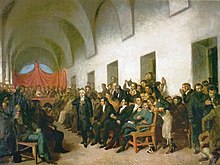Retroversion of the sovereignty to the people
The Retroversion of the sovereignty to the people, which challenged the legitimacy of the colonial authorities,[1] was the principle underlying the self-government temporarily in the absence of the legitimate king.
But, in both Spain and Spanish America, this principle was replaced by the concept of popular sovereignty, currently expressed in most constitutional systems throughout the world, whereby the people delegate governmental functions in their leaders and retaining the sovereignty. This was the principle underlying the Spanish American Independence processes
Historical development

In 1808, the Spanish King
The principle of retroversion of sovereignty was premised on the basis that the Spanish territories in America were a personal possession of the king of Spain, and not a colony of Spain. Only the king could rule over them, either directly or through viceroys appointed by himself. This principle already existed, and justified the fact that Spain and Spanish America had different laws. Scholars of the Laws of the Indies had argued that they were two different realms, united under one same crown.[3]
With the kidnapping,
The American new entities also adopted the principle of consentimiento (of consent). This meant that they felt free to reject any decision they had been taken without their consent.[4]
See also
Footnotes
- ^ Nuevas perspectivas en la Historia de la Revolución de Mayo Archived 2010-05-26 at the Wayback Machine (in Spanish)
- ^ a b c Ciudadanía y representación en el Perú (1808-1860).Gabriella Chiaramonti.2005 El código medieval de las Siete Partidas reconocía expresamente el derecho de los nobles, prelados, hombres de fortuna y otras personas «buenas y honradas» del reino a constituirse en juntas cuando, en ausencia del rey
- ^ ISBN 950-49-0656-7.
- ^ Fundamentos intelectuales y políticos de las independencias. José Carlos Chiaramonte 2010 En el caso hispanoamericano, ante la pretensión de lograr el reconocimineto de la metrópolis como autoridad sustituta del monarca, los criollos alegaban que su vínculo político era con la monarquía castellana y no con la nación española, y que, vacante el trono reasumían la soberanía.[...] Las nuevas entidades soberanas que se consideraban herederas de la soberanía de la corona castellana [...] los considerados organismos soberanos representativos de las ciudades y luego provincias o Estados iberoamericanos rechazaron decisiones tomadas sin su consentimiento.
